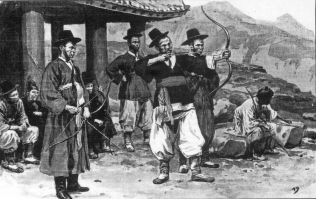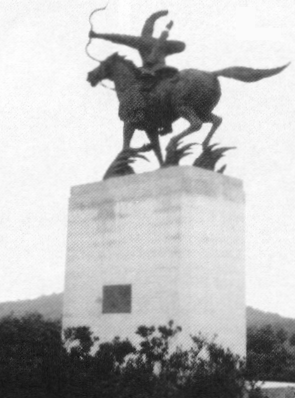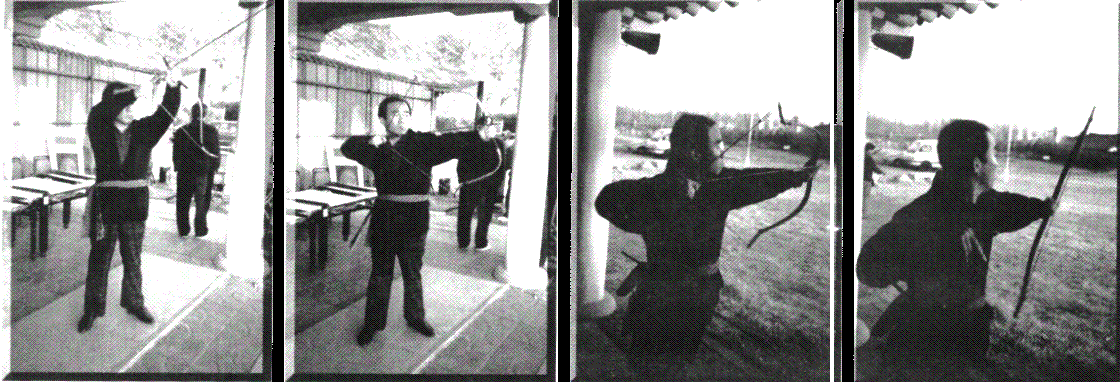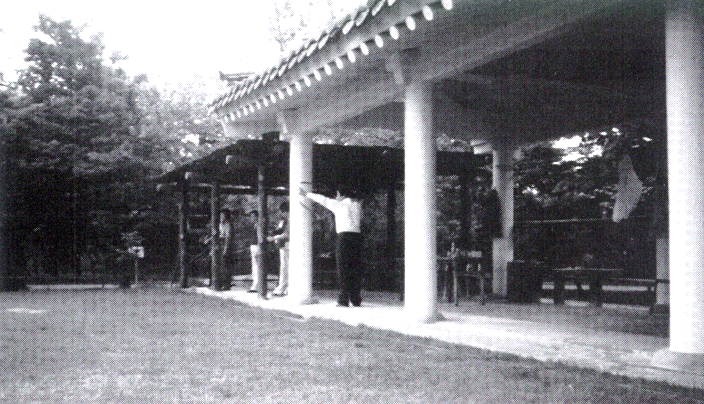
Drawing by Brtitish Officer Frank Dadd R.I., 1901
The Way of the Bow
© Thomas Duvernay, 1997
Re-printed with permission from
INSTINCTIVE ARCHER
MAGAZINE

Drawing by Brtitish Officer Frank Dadd R.I., 1901
Archery in Korea is probably as ancient as the country itself. Although other countries may claim the same thing, in Korea archery is still at the very heart of the country's culture. Korea has had archery, virtually uninterrupted, since prehistoric times. Before we begin discussing Korean traditional archery, we should briefly mention the Korean language.
The Korean alphabet (Hangul) is phonetic, with twenty four letters (ten vowels and fourteen consonants). It was invented during the reign of King Sejong in 1443 AD. Before that time, Koreans relied upon Chinese characters. For romanization, there are some conventions I will make and generally follow.
| VOWEL | SOUND | VOWEL | SOUND |
| Ae | Ae | O(h) | Oh |
| A(h) | Ah | Oo | Oo |
| E | Ay | U | Uh |
| I | Ee | Eu | Eu |
For consonants, I will use the letter sounds that are closest in romanization, with the exception of names that are already well established (with some exceptions to that, also). I think you should be able to catch on.
HISTORY
The bow was a vital part of Korea's defense from ancient times up through the nineteenth century. It was used during the Three-Kingdoms period, which ended in 668 AD (when the Silla Kingdom defeated Baekje and Koguryo Kingdoms, unifying the country). During the unification wars, Silla had elite young warriors, called Hwarang (Flower Knights). They were trained in both military and literary arts. They had five major precepts:
- Loyalty to the monarch
- Filial piety to parents
- Amicability among friends
- No retreat in war
- Aversion to unnecessary killing
The city in Korea where I live, Kyongju, was the seat of power for the Silla Kingdom. Outside the city's interchange is a statue of a Hwarang on horseback, with bow at full draw. On the outskirts of the city is the Hwarang Educational Center. This is a place where the academically and athletically elite youth of the country go for extended training. While in high school, my wife attended this center as a modern Hwarang. (It is interesting to note that archaeologists have found strong evidence to support the theory that the Kyongju campus of Dong Guk University where I teach was built upon the original Hwarang training grounds.)
After the Three-Kingdoms period, Silla gradually pushed back the Chinese Tang army. Originally, the Tang army was in Korea helping Silla defeat the other two armies. However, as it usually goes, they wore out their welcome. It took some time as successes went back and forth until 735 AD when the Tang finally gave in.
The next major point in Korean history where the bow played an important role was the Japanese Hideyoshi invasion of Korea in the late sixteenth century. Although the war was devastating to both countries, Korea successfully drove the Japanese back. During the war, Korean archers rained deadly salvos of arrows on the Japanese invaders. These were frequently at long distances.
Probably the last major use of the bow as a military weapon in Korea was in the nineteenth century. At that time they were defending against invaders from the Western Hemisphere (mainly France and the United States). In 1866, the United States tried opening Korea’s door, sending in the ship ‘General Sherman’. The ship was attacked and set on fire. Next, after a massacre of Catholics, France sent a squadron to Kanghwado. They, also, were repulsed by Korean units. The doors to Korea were finally opened, but not without valiant struggle by the Koreans.
In recent years, Korea has excelled in Olympic-style archery. A great percentage of the top ranked archers world-wide are from Korea. Some reasons for this include not only the transfer of traditional philosophy and training, but also the very practical reason that top athletes in Korea can gain benefits, both monetary and otherwise. The top archers spend their days not at a nine-to-five job, but training for their sport. Archery is taught uniformly among Korean archers; that is why they have generally uniform results-winners.

Hwarang statue outside Kyongju Tollgate
STARTING AT THE BEGINNING
Probably the most logical way for me to introduce you to Korean traditional archery would be as though you, the reader, just joined a club. I will show what would happen from first signing up to the end of your first competition. First, you should learn some terminology. I will romanize Korean terms and explain them briefly. I will not go into detail or list terms that are not important to this discussion.
GENERAL TERMS
ARCHERY:
GOONG DO
ARCHERY CLUB: JUNG (SA JUNG)
TARGET:
GWA NYUK
SHOOTING LINE: SA DAE
PERFECT END: MOLGI
PERSON MAKING
PERFECT END: JUB JANG
BOW TERMS
BOWYER:
GOONGSA
HORN BOW:
GAHK GOONG
(HWAL)
BOW COVER:
GOONG DAE
BOW STRING: GOONG
HYUN
UNBRACED BOW: BU RIN HWAL
BRACED BOW: UNJEUN HWAL
BOW HANDLE: JOOM TONG
SIYAH:
SAHM SAHM
ARROW TERMS
FLETCHER:
SHI JANG
BAMBOO ARROW: JOOK SHI (HWA SAL)
POINT:
CHOK
FLETCHING:
GEET
SHAFT:
SHI NU DAE
NOCK:
OH NEUI
ACCESSORIES
THUMB RING:
GAHKJI
ARROW CASE: JUN TONG
BRACE RING: SAM JI
GGEUN
SAJUNG FLAG: SA JUNG GI
ARROW RETURN: SAL NAL
TARGET JUDGE
FLAG:
HOIK JUNG
There are so many more terms, but these are the most basic.
Now that you have joined the club and learned some basic terms, it is
time for you to start your training. I will add new words and old Korean sayings in
italics. As a beginning archer, a shin sa, you will not start shooting yet. First,
you must learn how to hold the bow. We will use a modern bow for training. Grip the bow
firmly but not tightly. Grasp the bow as you would grasp an egg. The middle, ring,
and little finger are held together around the bow grip. The index finger is held a little
higher and is crooked downward. The thumb is held near the top of the grip and is crooked
in a little. There should be no gap between the thumb and index finger.
Ready to draw...
At
full draw...
Ready
to release...
The arrow
is on its way
Next you should learn how to draw the bowstring properly. For beginning training, you will draw with a three finger style, as it is easier than the Mongolian style. Pull straight back and hold for five seconds. After that, slowly let up on the string. Check the bow nocks to be sure the string is still centered. If not, keep trying. This practice should continue for a couple of days, preferably under the auspices of a trained archer. The hand with which you hold the bow should be like pushing a high mountain; the string hand should be like pulling a tiger’s tail.
The bow should be pushed using the ball of the palm of the hand, with power being shared equally with the arm holding the bow from wrist to shoulder.
If the bow is grasped so that the hand is bent back, power will not be distributed equally in the bow. This incorrect arm position will often make the arrow go wide of its mark. In this case, the bow should be re-grasped. The knuckle of the middle finger grasping the bow should be pushed toward the target. The bow arm elbow should be straight, with the inside of the elbow perpendicular to the ground. After you are able to consistently draw and relax the string, you now ready to shoot a tethered arrow.
The tether pole is usually made from a tall (20 ft.) bamboo shaft. A long line is attached to it and an old arrow is attached to the line through a hole drilled in the point. Before shooting, you need the correct stance and the correct way to hold the string. Your feet should be positioned at a two o'clock position (ten o'clock if left handed). The standing position, when shooting, should neither be a T shape, nor a V shape. The weight of your entire body should be evenly divided between the forward and backward feet. Your abdomen should be tight. If your abdomen isn’t strained to its fullest, it'll cause a loss of balance due to your haunches being pushed backward. Your abdomen can be naturally strained by standing with power in your legs.

The targets as seen from the Sa Dae (shooting line).
There are Chinese characters carved on the rock admonishing "Don't talk while
shooting.'
Correct breathing is essential. Take a deep breath, then release it slowly, emptying your lungs. Your chin should be positioned by your left shoulder (if you are right handed). Your neck should be held as straight as possible. Now you should put on your thumb-ring. Fit your thumb through the outer side of the ring and twist it so that the pointed end is toward the end of your thumb. Draw back on the string with it resting against the ring. Wrap your index finger around the end of your thumb. Draw back on the string with it resting against the string. Wrap your index finger around your thumb as if your were going to flip a coin. Be careful not to rest your finger over your thumb-nail. Raiseou your bow-hand to the height of your forhead, straightening out your bow-arm’s elbow. Your eyes should steadily gaze at the target, at the same height as the lower bow nock. Your jaw should be close to your bow-shoulder armpit. When you draw the string, you shouldn’t give power to the hand holding the bow first: draw the string first, then give power to the bow hand.
This hould be practiced until it become a steady, fluid motion. The string should be drawn back slowly to your string-hand shoulder. When at full draw, hold the position for about three seconds before releasing. The angle at which the bow should be held will depend upon the cast of the bow. Some archers shoot at a forty-five degree angle while others have a more flat trajectory. The angle can be adjusted individually. Release is made simply by relaxing the thumb-ring hand. Don’t jerk it. The follow-through should be a slow back and downward motion.
Now you are ready to practice shooting the tethered arrow for several days.
Now that you’ve practised shooting the tethered arrow, it is time for you to shoot a live arrow at the target, positioned 145 meters (158 yards) away. Remember a few basic rules:
1. Check the wind.
2. Stand straight.
3. Breathe from your lower abdomen.
4. Draw slowly.
5. Hold at anchor for three seconds.
6. Release smoothly.
When you first arrive at your jung, you will stand in front of a sign with the Chinese characters "Jung Gahn" carved into it. The meaning of the characters is literally "Righteous Space." The meaning is varied, depending on location. Generally, it is understood to mean you should be upright in both mind and body. Next, you will give a slight bow. As for clothing, Korean archers dress nicely. It is a widely-held belief in Korea that the clothes make the person. In competitions, archers are required to wear white shirts, white pants, and white shoes.
You should now prepare to shoot. First, brace your bow. As you are using a modern bow at this time, bracing is not a problem. It can be braced in a similar fashion to a western recurve. The horn bow will come later. Next, your bow cover should be tied around your waist. The tie should be made on your thumb-ring side. Start by tying it as though you were tying your shoe. Then loop the long end, bringing up the middle of the loop around the other side (ending up with half a bow, as though you tied your shoe and pulled too far). After you have accomplished the last feat, it is time to tie your arrows in the bow cover. Take five arrows and slide them under your bow cover on the thumb ring side, points in, feathers out. Twist them in the cover once, so they are firmly in place. The arrows should routinely be tested for straightness and soundness. The former is done first simply by sighting down the shaft; another way is to balance the shaft on your thumb nail and middle finger nail pressed together — spin the point as though you were snapping your fingers. If it spins easily, it is probably straight and balanced. Soundness can be tested either by bouncing the arrow on its point or by dropping it flat on the ground, listening for a crisp, sharp sound. If the sound is flat, don’t use it.
Before releasing the first arrow of the day, a Korean archer will say "Hwal bae oom ni da," which means "I'm learning the bow." If other archers are present, they would reply "Mani ma chu sayo," which means "Have many hits." Whether others are present or not you should still say this phrase, which is a reminder that, no matter how good an archer you are, you are always a student.
After you've practised for a time, you will eventually reach certain milestones in Korean archery. The first one is the first hit. When an archer hits the target for the first time, it is a special occasion (A hit is defined as an arrow hitting the target without breaking the plane of the target). First, you should bow towards the target (a practice that all novice archers must follow after making the first hit of the day). The next time you visit the jung, you should bring refreshments for the other members. For the second, third and fourth hits, congratulations are in order, nothing else. However, when you have a perfect score of five arrows hitting the target in a row, you have reached a very special level. This event is known as a molgi. The date and time should be noted. There should be witnesses. You should bow to the target whenever you make a molgi.
You will now be given a nickname, known as a muho. Usually, this name is given by the director of the jung. The name will usually describe something out of nature, When I reached this level, my director gave me the muho of Chung Ho, which means "Blue Lake." This was thought to be appropriate, as my hometown is in Michigan, the Great Lake State. Other members will call you by this name from now on. You will also be given an elaborate ceremony by the other members. During the ceremony, many rituals are performed and you will receive a certificate and trophy commemorating your achievement.
OFFICIAL RANKING
Korean traditional archery has ranking similar to other martial arts, such as taekwondo. The dahn level system is used. At special ranking competitions, archers try to advance in rank. The first dahn level is reached when you hit the target twenty five out of forty five tries. The next levels (second through ninth) are 28, 29, 30, 31, 33, 35, 37, and 39 hits, respectively. Only two level advancements are allowed per year. Rank is signified by moogoonghwa (Rose of Sharon) flowers embroidered on the archer's bow cover. When an archer reaches fifth dahn, another milestone is reached. This level is known as Myong Goong, or "Famous-name Archer". At this level, the archer will be given another ceremony and the archer's name will be registered nationally.

The shooting pavillion
THE GAME
The archery competition is divided into team and individual events. At some competitions, only dahn holders are allowed; at others, the competition is open to all. The competitions are further divided between city, province, and jung matches. In the city match, seven members will represent a city; teams from other cities will send their representatives. In the provincial match, the top five archers from the province will compete against the other provinces. In the jung matches, the top five from the jung will compete. We will concentrate on the jung match. Only in the jung match are modern glass fiber bows and carbon arrows allowed; in city and provincial meets, only the horn bow and bamboo arrows can be used.
We should, at this point, talk about the opening ceremony. Usually, several ends (soon) will be shot beforehand. At the ceremony, a moment of bowed silence is given to the national flag.
Next, the precepts of Korean traditional archery are read aloud by an emcee, a pledge is made by a chosen representative, and short speeches are given by VIPS. The whole thing takes fifteen to twenty minutes (members will be standing in front of the sa dae in rank and file.) Now, we can begin the competition in earnest.
First, there is the individual event. All members of all participating jungs can compete. The individual event is divided between the Men's Division and Women's Division. There is no difference in the rules between divisions. In individual competition, archers will be arranged in shooting groups called dae. Each dae will shoot three soon (ends) of five arrows, for a total of fifteen arrows. The archer with the best score out of fifteen wins. In the case of a tie, there will be a playoff. In team competition, the top five archers from each jung will shoot one soon of five arrows This is the quarter-final event, usually involving eight jungs. The semi-final event will be between the top four and the finals between the two winners of the semi-finals (Is there any other way?)
After the competition is finished (most will take several hours), it is time for the closing ceremony. Many awards will be given, from grand prizes (usually large trophies and pennants) to honourable mentions. Certificates seem to be everywhere. When it comes to traditional events, Koreans tend to be more geared to honours than to cash.
Now would be a good time to explain Korean manners, both archery-specific and general. Korea is a country with a very ordered society. This attitude comes from ancient Confucian teachings. You will find that many attitudes that are held in Western countries don't hold up in Asia. The opposite is also true. Let's look at some customs in Korea.
- Never beckon someone with your index finger; use your hand, palm down, similar to a wave.
- Don't drink directly from a bottle; use a glass.
- Don't lick your fingers while eating.
- Never give or receive anything with one hand; use two hands.
- Stand when elders or superiors enter a room.
- Pour drinks for others and let others pour for you (two hands).
- When entertaining out, try to pick up the tab, if possible (usually, everyone will try to be the one to pay for the bill)
PRECEPTS
The above-mentioned customs are just a few of the many. They are representative of those you will find in Korean archery. Korean traditional archery was founded upon traditional values, much like that of the Hwarang of the Silla Dynasty. There are nine major precepts in Korean values.
INTERVIEW WITH A MYONG GOONG
Now that we've looked a little at what Korean archery is like, let's have a talk with a true Korean archery master. His name is Mr. Bak Dong Sub (His muho is Duk Sahn). He passed Myong Goong level a couple of years ago. I'm very lucky to have him both as a friend and as my mentor.
What type of equipment do you prefer to use in Korean traditional
archery?
I will only use the traditional gahk goong (horn bow) and jook shi (bamboo arrows).
Is there any particular reason you like this type of equipment?
Yes. Nothing can beat the performance or feel of the gahk goong and jook shi. When you
shoot this type of bow, you don't get hand shock and the feeling upon release is
fantastic. Another reason is I love traditionalism. Anything else just wouldn't be
the same.
When did you first try Korean traditional archery that mirror those
traditional archery?
I first started in 1987, after a friend of mine introduced it to me. Shortly
thereafter, I was hooked. I've been. practicing this art ever since.
Do you have any special methods of training?
Practice, practice, practice. Nothing can replace practice. However, you have to
practice correct form, not mistakes. To do this, whenever I'm at a national competition, I
spend any free time I have studying the forms of other Myong Goong. I have learned many
new techniques that way.
What do you like most about Korean traditional archery?
The tradition involved. Tradition is everything.